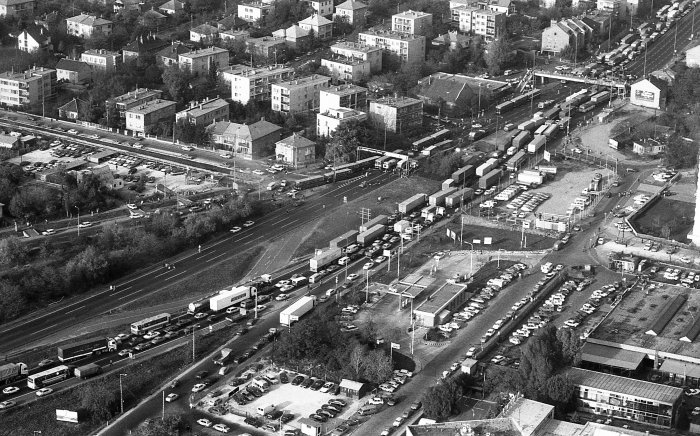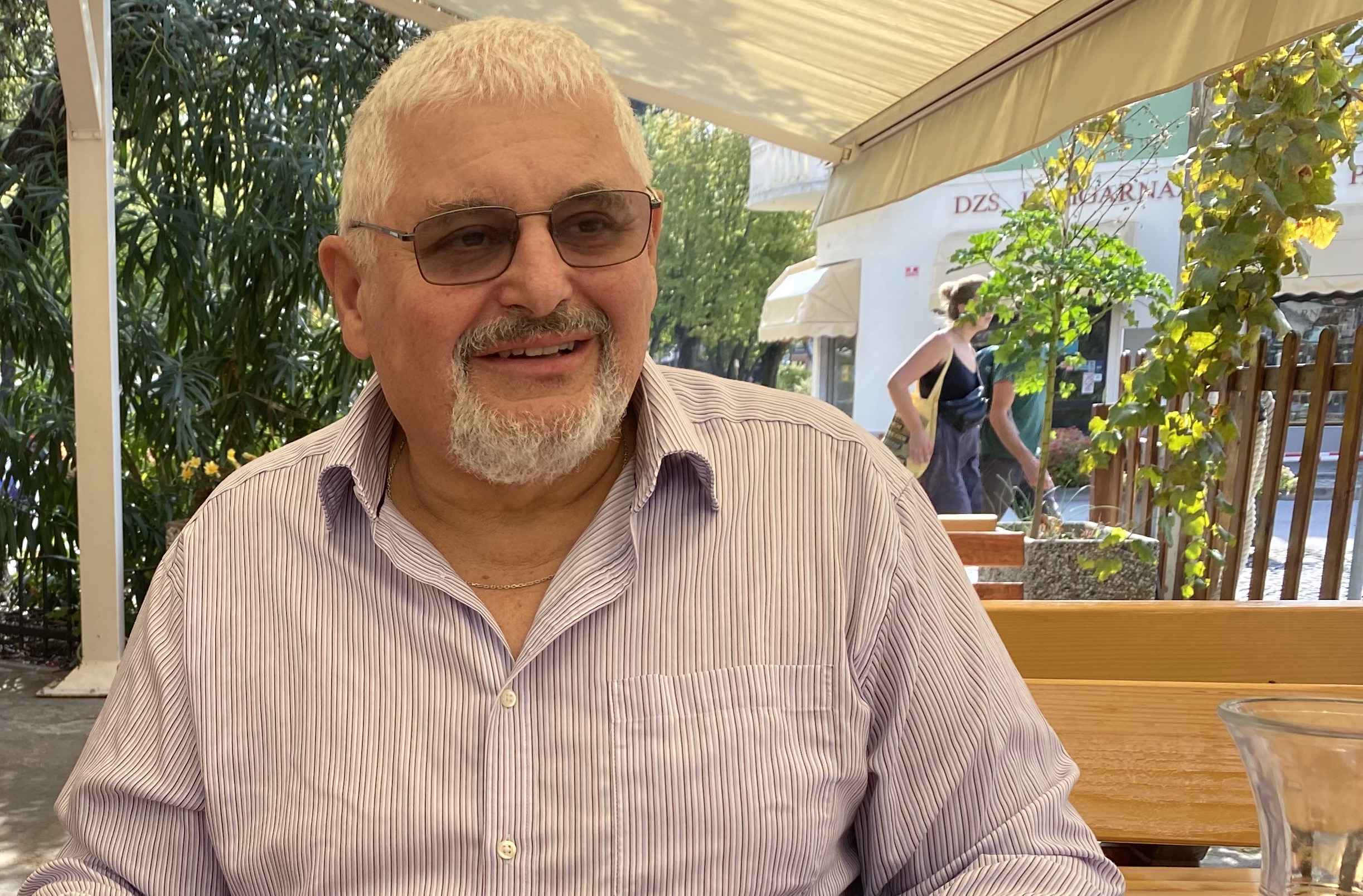Taxi Blockade: A Chronicle of Four Remarkable Days

Fortepan/Zoltán Szalay
In the last days of October 1990, the price of petrol in Hungary soared overnight by about 65%. Protesting against the increase, taxi drivers and private carriers first blocked roads in Budapest, then nationwide, paralyzing traffic for days. It was serious enough that Prime Minister József Antall was forced to work from his hospital bed to find a solution for what became known as the “taxi blockade.”
Aerial photo of the intersection of Budaörsi út and the M1-M7, with Beregszász út on the left, and an auto car service on Boldizsár utca on the right (Budapest, District XI). Photo by Fortepan/Zoltán Szalay.
In doing its best to reduce the huge public debt inherited from the previous regime, the Antall government has had to deal with a series of serious conflicts and conflicts of interest. Thirty years on, the October 1990 taxi blockade still divides politicians and public alike: many recall it as the first mass demonstration in democratic Hungary; others see it as an arbitrary action by a group of entrepreneurs that paralyzed others.
The price increase was officially announced on October 25, but had been preceded by controversial rumors. On October 19, the first news item about the possible price increase appeared in Népszava entitled “Betrayal: HUF 56-62 Gasoline is Coming”, while Magyar Hírlap reported on October 24 that petrol would become more expensive from October 29.
State news agency MTI reported that gasoline price increases were not on the agenda of the government’s October 25 meeting. Nevertheless, a 65% increase in fuel prices was announced at a parliamentary press conference that afternoon. According to the government, the price increase was triggered by the decline in Soviet oil supplies and by the First Gulf War, which had begun on August 2.
Outraged taxi drivers gathered on October 25 at Hősök tere in Budapest and then at Kossuth tér, in front of the Parliament, where they met with Minister of Transport Csaba Siklós, although he refused to receive their petition.
The taxi drivers decided to widen their protest: keeping in touch with each other via their radio network, they blocked all the bridges in Budapest, crippling the city’s traffic flow. From midnight, the blockade went nationwide, joined by both private and freight carriers.
The next day, October 26, movement was almost impossible on the country’s main roads and in larger cities, with traffic also building up at the borders. Budapest Ferenc Liszt International Airport, then known as Ferihegy Airport, could not be reached from the capital, only the metro ran in the inner areas of the city. Demonstrators, however, did let ambulances and other emergency vehicles and lorries transporting food through their blockades.
Government spokesman Balázs László described the action of taxi drivers as illegal on the morning of October 26, citing the fact that it had not been announced 72 hours earlier in accordance with the provisions of the Assembly Act.
The government had certainly been caught unawares by the protest; four of the 11 ministers were abroad, and Prime Minister József Antall was hospitalized.
(As is now well known, but was not at the time, the prime minister had been diagnosed with non-Hodgkin lymphoma in the summer of 1990. He had undergone an operation just two days before the blockade, and would not see out his term in office: he died on December 12, 1993.)

Margit híd (Margaret Bridge) during the blockade. Photo by Fortepan/Zoltán Szalay.
Order by All Means
In his absence, the Minister of the Interior, Balázs Horváth, performed the duties of the Prime Minister, and announced that the government would restore order by all legal means. In a speech broadcast on radio and television, he justified the government’s action and announced that three crisis teams had been set up.
President Árpád Göncz made a public address on television that evening, proposing that the government suspend the increase in petrol prices and, in response, that the taxi drivers end their blockade.
On October 27, Hungary awoke to a complete blockade of its roads. Taxi drivers and haulers, along with members of the public who joined them, paralyzed the country. Road barricades were erected in an estimated 600 locations, affecting a total of 105 settlements. In Budapest, with the exception of the Chain Bridge, all Danube bridges were closed and 25 major junctions were blocked. German Chancellor Helmut Kohl and Austrian Chancellor Franz Vranitzky both offered to help.
Negotiations between the carriers and the government lasted all day. In the evening, it was agreed to publish a joint statement. In this, the government announced that it would present a solution to a meeting of the Conciliation Council to be held on October 28, through which a discount of HUF 10 per liter could be envisaged under certain conditions. The agreement was made conditional on the lifting of the blockade.
Based on a preliminary agreement between the government and the carriers, at midnight, National Chief of Police Győző Szabó called on the protesters to remove the barriers.
By the morning of October 28, the blockade had eased somewhat, though it was far from universally lifted. At noon, the meeting of the Conciliation Council began at the Ministry of Social Affairs and Labor and was broadcast live on television at the request of the carriers.
On behalf of the government, Minister of Industry and Trade Ákos Péter Bod and Minister of Finance Ferenc Rabár led the negotiations, the workers’ delegation was headed by Pál Forgács, President of the Trade Union Roundtable and the Democratic League of Independent Trade Unions (FSZDL), and Sándor Nagy, National Association of Hungarian Trade Unions, while the employers were represented by János Palotás, President of the National Association of Entrepreneurs (VOSZ).
The meeting was chaired by István Orbán, vice president of the Hungarian Chamber of Commerce.
According to the agreement reached that evening, the increased petrol prices were to be reduced by HUF 12 from midnight on October 29, and the new prices would be valid until laws related to price liberalization come into force.

Kossuth Lajos tér (Budapest, District V), in the background the MTESZ house on the left. At center right is one of the main organizers of the taxi blockade, Pál Horváth. Photo by Fortepan/Zoltán Szalay.
Blockade Lifted
Within a few hours of the news of the agreement, the blockade was completely lifted throughout the country, and traffic was restored.
After signing the agreement, Prime Minister József Antall made a television statement to the television from his hospital bed. In what perhaps inevitably became known as his “pajama interview”, Antall analyzed the situation in the country, evaluated the compromise that had resolved the crisis, and acknowledged that his government had made mistakes in preparing for the announcement of the gas price increase.
He said there were no losers or winners in the situation and promised that the government would not act against those involved in the “civil dissatisfaction movement”.
Viewed from this distance, it would be easy to regard the taxi drivers’ blockade simply as an example of mass industrial unrest, but not everyone agrees with that assessment. In 2016, the Institute and Archive for the History of Regime Change (Retörki) analyzed the events and background of the blockade in a two-volume, 700 page summary.
“Here, the program was the overthrow of the government,” remarked Zoltán Bíró, the general director of Retörki, at the time of the presentation of the dissertation. According to him “this is how the SZDSZ wanted to achieve what it did not succeed in the elections.”
He added that the country had been close to a civil war situation developing in those days.
Subsequently, at the spring session of Parliament, President Árpád Göncz submitted a bill offering an amnesty. The taxi blockade had resulted in hundreds of thousands of participants nationwide committing crimes because the demonstration was not announced 72 hours before it began and had paralyzed the operation of public utility plants. With the enactment of the Public Amnesty Act, the state dropped charges.
Political parties had also joined the argument: opposition SZDSZ politicians spoke at the barricades, and the ruling Hungarian Democratic Forum tried to win sympathy for its cause. Viktor Orbán, the young leader of the then liberal opposition Fidesz party, said in a speech to parliament after the three-day crisis that the government had lied because it denied that it was preparing to raise prices before the announcement.

Örs vezér tere (Budapest, District XIV), the overpass in front of the Sugár Shopping Center. Photo by Fortepan/Zoltán Szalay.
Dented Prestige
The blockade severely damaged the prestige of the Antall government, which had proclaimed a “social market economy.” Minister of the Interior Balázs Horváth was unable to handle the situation in place of the ailing Antall; President Árpád Göncz had managed to take some of the heat out of the situation by stating that, as the head of state and commander-in-chief of the army, he would forbid its deployment. Plenty of simple sympathizers took the side of the taxi drivers, offering food and drink to those manning the barricades.
The four-day blockade can be seen as the beginning of the end for the first freely-elected post-communist Hungarian government, but also the first serious test of the country’s fledgling democracy. Ironically, though, rather than the highly active Free Democrats (SZDSZ), it was the reborn Socialist Party (MSZP) under Gyula Horn that was to reap the laurels of dissatisfaction by winning the 1994 general election.
The success of the taxi blockade was basically down to two things: in 1990, there were more taxi drivers in Budapest than in New York, according to an Origo article from 2005, which claimed nearly 20,000 drivers held a license and another estimated 5,000 worked illegally. As regulations were tightened through the ‘90s and subsequent decades, more and more gave up the profession.
(Editor’s note: If that number makes it seem everyone must have been a taxi driver, perhaps they were. Certainly, I was told when I first arrived in Hungary in 1998 that Gábor Demszky, the SZDSZ Mayor of Budapest from 1990-2010, had fought his first election partly on a campaign of knowing the problems of the city’s streets better than other candidates from his time as a taxi driver.)
Another factor in the success was that the taxi drivers had a communication network that was only available to the police, ambulance service and the army at the time. In a time before widely available cell phones, CB radio provided a system that allowed the demonstration to paralyze the country.
At the same time, it is thought-provoking to note that CB communications are not encrypted, so anyone with a handset (including law enforcement units) could easily listen in, yet the organization was successful. According to some, this was another reason for the introduction of the so-called CEPT standard, which practically buried CB radio alive.
SUPPORT THE BUDAPEST BUSINESS JOURNAL
Producing journalism that is worthy of the name is a costly business. For 27 years, the publishers, editors and reporters of the Budapest Business Journal have striven to bring you business news that works, information that you can trust, that is factual, accurate and presented without fear or favor.
Newspaper organizations across the globe have struggled to find a business model that allows them to continue to excel, without compromising their ability to perform. Most recently, some have experimented with the idea of involving their most important stakeholders, their readers.
We would like to offer that same opportunity to our readers. We would like to invite you to help us deliver the quality business journalism you require. Hit our Support the BBJ button and you can choose the how much and how often you send us your contributions.









